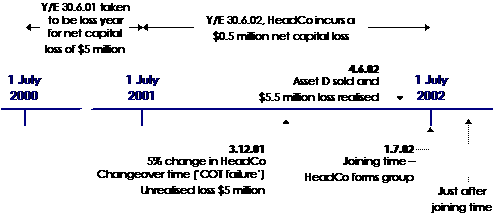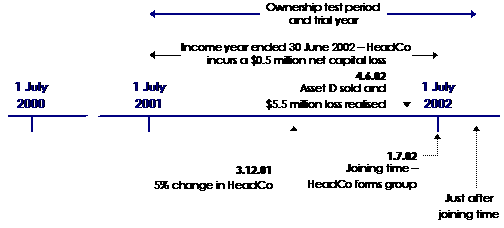Consolidation Reference Manual
You can still refer to the Consolidation reference manual for consolidation information that has not been impacted by changes in the legislation.
C3 Losses
C3-3 Worked example - loss transfer
Transfer testing
C3-3-260 Transfer testing where Subdivision 165-CC applies to a net capital loss that is unutilised at the joining time
Description
This example shows how Subdivision 165-CC applies to a net capital loss that remains unutilised at the joining time and is to be tested to determine whether it can be transferred to the head company under Subdivision 707-A.
Commentary
When transferring losses under Subdivision 707-A, in certain circumstances section 707-120 requires that Subdivision 165-CC be considered. Three key elements are necessary for Subdivision 165-CC to apply:
- 1
- The company has a 'changeover time' after the 'commencement time.'
- The company's commencement time is 1 pm ACT time on 11 November 1999 - or, if the company came into existence after that time, the time when it came into existence. [F1]
- A changeover time occurs, broadly, where there is a change in the company's ownership or control. [F2] In determining whether there has been a change of ownership (or control), the reference time is the later of the commencement time (11 November 1999) and the time immediately after the latest changeover time. [F3]
- 2
- The company has an unrealised net loss (at the changeover time)
- The unrealised net loss at changeover time is calculated in accordance with the rules set out in sections 165-115E and 165-115F. In essence, an unrealised net loss is the excess of unrealised losses on assets of the company at the changeover time over any unrealised gains on assets.
- In calculating the unrealised gains and losses on assets, the assets are deemed to be disposed of for market value at the changeover time. Gains and losses on revenue assets, including trading stock, are included in the calculation of the unrealised net loss. Gains and losses on pre-CGT assets are also included.
- 3
- There is a subsequent realisation of a (capital/revenue) loss on assets held at the changeover time
- If there is a subsequent realisation of a loss on an asset held at the changeover time, then to the extent of the residual unrealised net loss (RUNL) [F4] in respect of the company, the same business test (SBT) must be satisfied for the company to be able to utilise the loss.
- The legislation deems the realised capital loss, deduction or trading stock loss to be a loss (a net capital loss or tax loss) of the income year immediately preceding the income year in which the changeover time occurred. [F5] The company is also deemed to fail the continuity of ownership test (COT) at the changeover time and therefore cannot deduct the loss unless it passes the SBT. [F6]
- Although the loss or deduction is deemed to be a loss of the income year immediately preceding the income year in which the changeover time occurred, it cannot be utilised before the income year in which the company actually made it. [F7]
Example
Facts
On 3 December 2001, HeadCo had a changeover time under Subdivision 165-CC, as a result of a 5% change in its ownership. There had previously been a 47% change in its ownership, which occurred on 15 March 2000, and this was HeadCo's only other ownership change since 1 pm legal time in the ACT on 11 November 1999 (the commencement time). At the changeover time, HeadCo calculated an unrealised net loss of $5 million and the following asset was held:
| Asset | Reduced cost base | Changeover time market value |
|---|---|---|
| D | $6 million | $1 million |
On 4 June 2002, asset D was disposed of for $0.5 million - a capital loss of $5.5 million (i.e $6 million minus $0.5 million). On 1 July 2002, HeadCo and its subsidiaries form a consolidated group, and there is no new changeover time for HeadCo or its subsidiaries at that time.
The capital loss is not able to be utilised in the income year ended 30 June 2002 as there are no capital gains, and it is HeadCo's only unutilised loss at the joining time. HeadCo seeks to transfer its net capital loss(es) under Subdivision 707-A.
Calculation
Application of Subdivision 165-CC
In this case, the $5.5 million loss on the disposal of asset D exceeds the RUNL balance of $5 million, which means the RUNL balance is reduced to $0 at the time of the disposal on 4 June 2002.
Under subsection 165-115B(2), $5 million of the $5.5 million capital loss that HeadCo made on 4 June 2002 is taken to be a net capital loss made in the income year ended 30 June 2001. This leaves the remaining $0.5 million capital loss as being made by HeadCo on 4 June 2002 (i.e when asset D was disposed of).
Under subsection 165-115B(3), HeadCo is taken to have failed the COT in respect of the loss on 3 December 2001. Therefore, for the purposes of applying the SBT in respect of the loss, the continuity period is taken to have ended on 3 December 2001.
In respect of the $0.5 million capital loss made by HeadCo on 4 June 2002, this is available to be offset against any capital gains made in the income year ended 30 June 2002. As there are no capital gains made by HeadCo in the income year ended 30 June 2002, HeadCo has a net capital loss in the income year ended 30 June 2002 of $0.5 million (by applying the method statement in subsection 102-10(1)).
Figure 1: Timeline of events

Application of Subdivision 707-A
Subsection 707-120(1) provides that a loss is able to be transferred to HeadCo (from itself in this instance) if HeadCo (the joining entity) could have utilised the loss for an income year consisting of the trial year - which in this case is 1 July 2001 to just after 1 July 2002). In this case, the transfer testing process needs to apply to each of the net capital losses incurred by HeadCo.
2001 net capital loss
HeadCo would only be able to utilise the $5 million 2001 net capital loss in the trial year if it satisfied the SBT (as it has been taken to have failed the COT in respect of the loss on 3 December 2001).
The modified SBT in section 707-125 applies as the loss is made by HeadCo in the income year ended 30 June 2001 (i.e. HeadCo incurs the loss in an income year starting after 30 June 1999).
Figure 2: SBT testing times for 2001 net capital loss

Applying the modified SBT in section 707-125, HeadCo will be able to transfer the 2001 net capital loss if it is able to satisfy the SBT in respect of the trial year (i.e. 1 July 2001 to just after 1 July 2002 [F8] ) and just before the end of the income year in which the loss is made (i.e. just before the end of the income year ended 30 June 2001). The income year in which the continuity period ends (i.e. the income year ended 30 June 2002) is not separately examined, as it does not begin before the start of the trial year.
2002 net capital loss
In respect of the $0.5 million net capital loss incurred by HeadCo in the income year ended 30 June 2002, HeadCo has had a 5% change in its ownership from the start of the loss year (i.e. 1 July 2001) to the end of the trial year (i.e. just after the joining time on 1 July 2002).
Therefore HeadCo has maintained majority ownership since the start of the loss year (i.e. it has maintained 95% ownership) and satisfies the COT in respect of the loss. Assuming that the control test has not been failed, the 2002 net capital loss is transferred to HeadCo as a COT transfer as defined by subsection 707-210(1A).
Figure 3: COT testing of 2002 net capital loss

References
Income Tax Assessment Act 1997 :
- •
- Division 102:
- •
- Subsection 102-10(1);
- •
- Subdivision 165-A:
- •
- Subsections 165-12(2), (3) and (4)
- •
- Subdivision 165-CC:
- •
- subsection 165-115A(1)(c)(i)
- •
- subsection 165-115A(2)
- •
- subsection 165-115A(2A)
- •
- subsections 165-115B(1) , (2) , (3) , (4) , (5) and (6)
- •
- subsections 165-115BA(4) & (5) (5)
- •
- subsection 165-115BB(2)
- •
- section 165-115C
- •
- section 165-115D
- •
- section 165-115E
- •
- section 165-115F
Income Tax Assessment Act 1997 - as amended by New Business Tax System (Consolidation) Act (No. 1) 2002 (No. 68 of 2002), Schedule 1:
- •
- Subdivision 707-A:
- •
- subsection 707-120(1) & (3)
- •
- section 707-125
Income Tax Assessment Act 1997 - as amended by New Business Tax System (Consolidation and Other Measures) Act 2003 (No. 16 of 2003), Schedule 13:
- •
- subsection 707-210(1A)
Current at 28 May 2003
Subsection 165-115A(2)
Section 165-115C and section 165-115D
Subsection 165-115A(2A)
Subsection 165-115BB(2)
Subsections 165-115B(1) and (2) and paragraph 165-115BA(5)(a)
Subsections 165-115B(3) and (4) , and subsections 165BA(4) and (5)
Subsections 165-115B(5) and (6)
Subsection 707-120(3) provides that the business carried on at and just after the joining time is taken to be the same as the business conducted just before the joining time.
